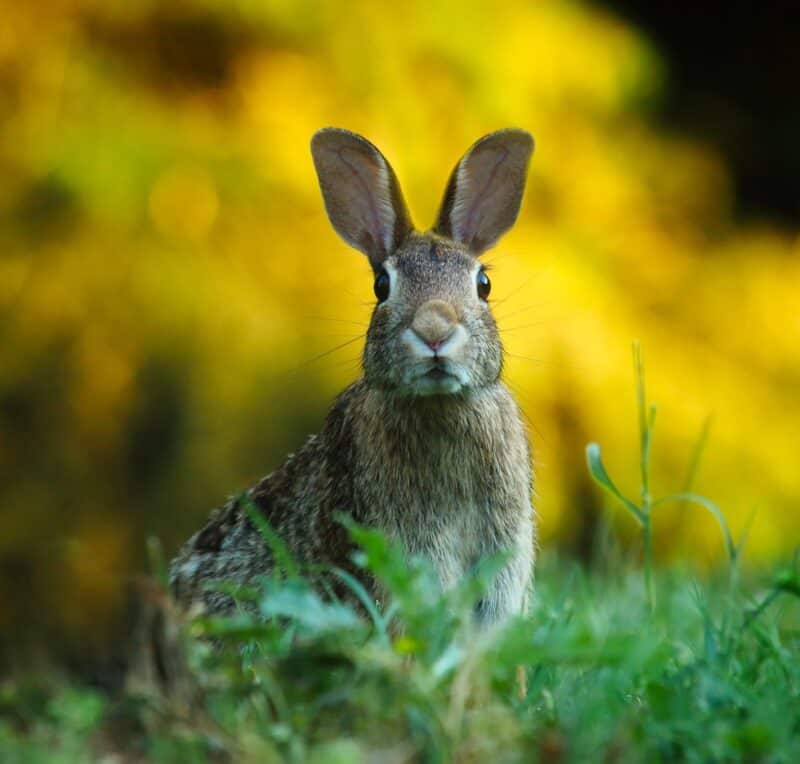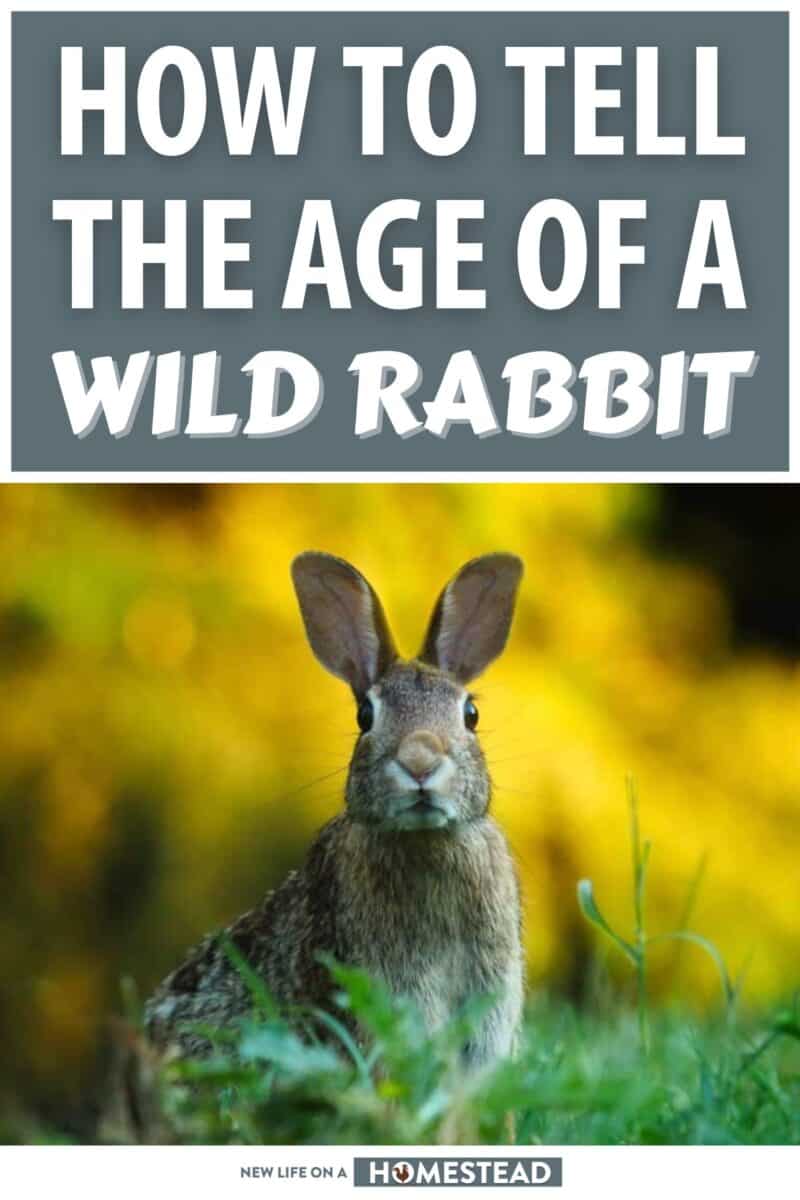It’s a good idea to learn how to tell the age of wild rabbits, and here’s why…
Knowing how old they are can inform whether or not you might need to intervene in case a litter of kittens has been abandoned, or how healthy and how fast your local rabbit population is growing.

Plus, it’s just a cool bit of wilderness lore that you can add to your repertoire. So, how can you tell the age of a wild rabbit?
Telling the age of a newborn or young wild rabbit is easily done by looking at physical cues such as the separation of the ears and the opening of the eyes. Accurately telling the age of a mature adult rabbit conversely is pretty difficult.
If you’ve stumbled across a nest of baby cottontails or other wild rabbits, you should easily enough be able to tell how far along the young ones are.
But there’s only so much you can do to determine the age of an adult. Keep reading and I’ll tell you what you need to know about figuring out the age of wild rabbits…
Rabbit Kittens are Born Bald, Blind, Deaf, and Helpless
The first thing that you need to know is that baby rabbits, as opposed to wild hares, are born completely helpless. In fact, they’re born looking significantly underdeveloped!
Baby rabbits are born nearly bald, blind with their eyes closed, deaf (since their ear holes haven’t opened) and almost entirely unable to move.
They are a pretty pitiful sight at this age, and completely dependent upon their mother’s help for nourishment in the form of milk and security that only their nest can provide.
Baby rabbits grow quickly, no doubt about it, but if you find a nest of these little “pinkies”, you know they have only been born for a day or two at the most.
Their mother is almost certainly nearby, but if you know she’s come to a bad end, you’ll need to take action.
In any case, keep reading for more developmental benchmarks for young rabbits.
Newborn: Less than 3 Days Old
The youngest, truly newborn baby rabbits, sometimes colloquially called pinkies, are rarely more than a couple of inches long and incredibly delicate.
Their bodies appear basically transparent and veiny, though they might have a very short, super-fine layer of fur which can be light or dark in appearance.
They can barely move on their own, really able to do anything more than wiggle or move their heads.
At this stage, both their eyes and their ears will be closed.
Growing: 3 to 9 Days Old
Baby rabbits in his phase will have grown noticeably by this time, but there are still tiny.
Therefore, they’ll enter the peach fuzz stage, growing slightly thicker, longer, and developing slightly more color which will contribute to a healthier and more natural appearance overall.
They’re still pretty much unable to move, but they will wiggle more and some healthy specimens in certain species will be barely crawling by now.
Their ears will begin to protrude from their heads, and anywhere from 7 to 9 days old, the ear canal will open and the baby bunny will be able to hear properly for the first time.
The eyes will remain closed slightly longer, usually opening anywhere from 8 to 10 days of age.
The opening of the eyes is one of the surest physical indicators of the age of a baby bunny: If the eyes are open, you know they’re at least a week old and probably slightly older.
Closed eyes means they are definitely younger than a week – assuming they aren’t sick.
Filling Out: 10 to 14 Days Old
Closing in on the 2-week mark on the calendar, a baby rabbit’s body will be noticeably more elongated and proportional.
The fur will be developing quickly and nicely, showing distinctive colors and patterns for its species.
The little things start to become significantly more mobile by this point, sitting upright and even taking a few tentative hops or repositioning themselves around the nest.
The babies at this point are significantly more aware of their environment, with eyes and ears fully opened and attentiveness significantly increased.
Be on the lookout for the ears to stand properly upright. Baby bunnies at this phase still depend upon their mother for milk, but they’ll begin taking their first bites of solid food around this time.
Adolescence: 2 to 3 Weeks Old
Baby rabbits are growing much more quickly by this phase, and dramatically so. Most species will be longer than 4 inches and their muscles and skeleton will be developing rapidly.
This greater mobility will allow them to move around the nest with vigor now, and some adventurous ones will even leave the opening of the nest for short times but will stay nearby.
Some bunnies will be notably playful with their siblings…
Their fur will have all the hallmarks of maturity in terms of texture, pattern and color, although it still has a ways to go before it is fully developed and thick to provide them with adequate insulation in all conditions.
Almost Grown: 3 to 5 Weeks Old
Baby bunnies are growing very rapidly by this stage and will soon be fully mature, physically. The ears will be lengthening and fully erect.
Their eyes will be bright, clear, and responsive to light, movement and the presence of any threat.
Most rabbits will measure 6 to 7 inches long, and will look very much like a miniature adult rabbit.
Their fur will be completely developed, plush and silky, very much like an adult rabbit but it is typically still softer and somewhat more lustrous than an adult’s.
The “babies” by this stage are moving around readily, hopping, playing and running around with energy and enthusiasm.
They will also venture further and further from the nest and from their mother although they aren’t truly weaned yet. Solid foods will be a regular part of their diet from here on.
Physically Mature: 6 Weeks Old or Older
The final phases of adolescence conclude around the six-week old mark.
Even though they’re still quite young rabbits are fully developed physically and mentally by this point although they are not yet sexually mature and ready to reproduce.
Depending on the breed, rabbits at this stage are anywhere from a foot to a foot and a half long, and may weigh 2 to 3 pounds.
They may grow slightly bigger depending on the breed, because some species are slower growing than others, but they are, for all intents and purposes, fully fledged adults.
They will be extremely active, completely weaned, and ready to live without the assistance of their mother, even though some might decide to remain inside the warren as part of the family unit.
Can You Accurately Tell How Old an Adult Rabbit is?
Typically no. Adult rabbits show very little change over time in regards to age when in the wild.
Although it’s a relatively easy affair to make a good estimate of how old an adolescent or baby rabbit is based on physical benchmarks, the same cannot be said for an adult rabbit…
About the best you can hope for is to look for signs of sexual activity.
A rabbit will show all the signs of physical maturity around 6 weeks of age, but the sexual organs and true sexual maturity won’t be fully developed until around 8 weeks of age or so.
Senior Rabbits Usually Look and Act Differently from Younger Adults
If you’re looking out for a truly elderly rabbit in the wild, you’re probably going to have a hard time spotting him, physically.
Senior rabbits typically don’t turn “old and gray,” though you might notice that their fur is distinctly thick, coarse, and wiry looking.
Also, older rabbits, like most elderly animals, are nowhere near as quick, vigorous, and responsive as younger adults.
If you see a mature rabbit in the wild that is a little “slow on the draw” in responding to threats and other stimuli (assuming it is not sick), there’s a good chance that it has lived to a ripe old age and is simply slowing down.
Rabbits Don’t Live Too Long in the Wild
Further complicating matters when it comes to positively determining the age of an adult wild rabbit is the fact that rabbits just don’t live very long in nature.
Many won’t live longer than 12 months depending on the presence of predators in their area, and it’s a rare thing indeed for a rabbit to live more than a few years in the wild even under ideal conditions.
Accordingly, there’s not much time for rabbits to truly get old and show physical indicators of advanced age as described above.
For this reason, is a safe bet to say that most wild rabbits are no older than a couple of years assuming they show all signs of physical maturity.

Tom has lived and worked on farms and homesteads from the Carolinas to Kentucky and beyond. He is passionate about helping people prepare for tough times by embracing lifestyles of self-sufficiency.
